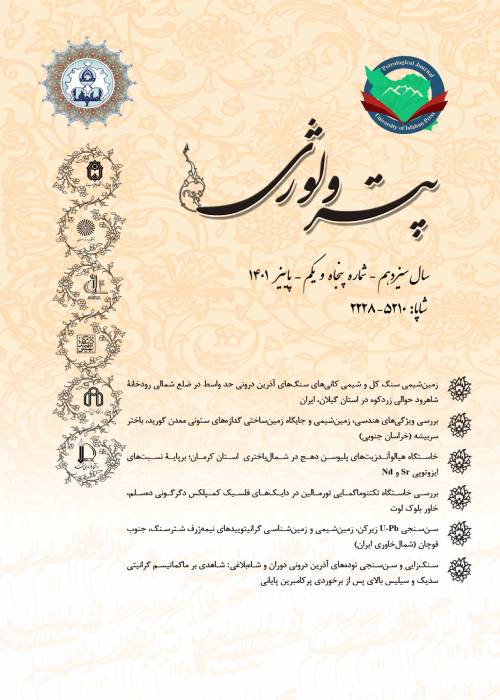Petrology and geochemistry of Noraldinabad rhyolites, NW Iran
Felsic igneous rocks record crustal evolutions and provide an important tool for determining the composition and modification of the crust (Zhang et al., 2018). Up to now, several classifications have been proposed for granites and rhyolites. Alphabetic classification is the most common approach used by petrologists. In this approach, granites and rhyolites have been divided into I, S, M, and A-types according to their geochemical, mineralogical composition, and origin characteristics (Loiselle and Wones, 1979; White, 1979). A-type granites and rhyolites include a wide range of felsic rocks. Currently, the formation of A-type suites has been attributed to both with-in-plate (anorogenic) and postcolision (orogenic) settings (Eby, 1990; Bonin, 2007; El Dabe, 2015).In this study, petrological characteristics of Noraldinabad rhyolites have been studied. These rhyolites exposed adjacent to Gushchi granitoids, which petrologically, have been studied before (e.g. Advay et al., 2010; Shafaii Moghadam et al., 2015). These studies exhibit that the Gushchi granitoides are A-type and formed in an extensional rift-related setting. Nevertheless, there is not any comprehensive study on the Noraldinabad rhyolites and the present study would be the first effort to constrain the geochemical characteristics of these rocks.
Regional Geology:
The area of study, in aspect of lithological characteristics as well as geological structures has attributed to various zones e.g., Khoy-Mahabad zone (Nabavi, 1976), Sanandaj-Sirjan Zone (Alavi, 1991), and junction of the structural zones of Sanandaj-Sirjan and Central Iran (Alavi-Naini, 1972). Nabavi (1976) believes that the lithological characteristics of Central Iran, Sanandaj-Sirjan, and Alborz-Azerbaijan zones are visible in the northwest of Iran. In this case, the observed geologic successions in the northwest Iran are similar to those of the of Central Iran zone (Shafaii Moghadam et al., 2015). The exposure of Kahar Formation (Late Neoproterozoic) is common in the northwest of Iran, Central Iran, Alborz, and Sanandaj-Sirjan zones (Shafaii Moghadam et al., 2015). However, according to Sabzehi and Mohammadiha (2003), the main characteristics of the Sanandaj-Sirjan zone are not visible in this region but could be considered as the northwest termination of the Sanandaj-Sirjan zone.
Following the field observations and collecting several rhyolite samples microscopic studies were performed to determine petrographic features. Also, 10, least altered rhyolite samples, were selected for whole rock analyses, including XRF and ICP-MS, performed at the Zarazma Zanjan laboratories (Zanjan, Iran).
Petrography:
The Noraldinabad rhyolites display porphyritic texture with quartz, alkali feldspar, and subordinate plagioclase phenocrysts. Opaque minerals and zircon are the main accessory minerals. Altered mafic minerals can be seen in some samples. The matrix is composed of medium- to fine-grained quartz and alkali feldspar. Secondary minerals, mostly sericite and chlorite, are ubiquitous in the matrix of some samples. Along with porphyritic texture, flow-alignment (in the matrix of some fine-grained samples), spherulitic (in the matrix of medium-grained samples), embayed, Perthitic, and subordinate granophyric textures are the main visible textures.
Whole rock chemistry:
The Noraldinabad rhyolites have high SiO2 values, consistent with “high silica rhyolitic systems” (SiO2 > 70 wt%) (Gualda and Ghiorso, 2013; Arakawa et al., 2019). The Al2O3 content of the studied rhyolites is lower than of \ this oxide in calc-alkaline rhyolites (> 14 wt%) (Philpotts, 1990). Based on alkali elements content, the rhyolites under study can be divided into two groups: Na2O- and K2O-rich, in concordance with petrographic studies. The K2O-rich samples are dominated by the presence of K-feldspar whereas the Na2O-rich samples are characterized by high numbers of anorthoclase. Except for alkali elements, the contents of other major elements in these two groups are not significantly different. Except for one sample (0.54), the FeOt/(FeOt+MgO) ratio is high and varies between 0.73 to 0.94. All analyzed samples have high A/CNK ratios, indicating their peraluminous characteristics. The studied rocks show shoshonitic magmatic series affinity and are characterized by LREEs enrichment and HREEs depletion with obvious negative Eu anomaly in the chondrite-normalized diagrams. In the NMORB-normalized trace element spider diagram, the samples display enrichment in LILEs, Ba, Nb, Ta, Sr, Zr, Hf, Eu, and Ti negative anomalies, weakly Rb and Pb positive anomalies. The Eu, Sr, Ba, and Ti depletion indicates plagioclase and titano-magnetite fractionation, respectively (Shafaii Moghadam et al., 2015).
The remarkable geochemical features of the Noraldinabad rhyolites are high amounts of SiO2, Na2O+K2O, Fe2O3t and low abundances of CaO, MgO, and P2O5. Furthermore, the concentration of REEs (except for Eu) and LILEs are high, and the contents of Sr and Rb, and compatible elements (i.e., Co, Sc, Cr, and Ni) are low. These geochemical features disclose the A-type nature for the studied rhyolites (Loiselle and Wones, 1979; Eby, 1990; Bonin, 2007). Genetically, considering the high ratios of Y/Nb, Rb/Sr, Rb/Nb, and relatively low amounts of Nb, the investigated rocks can be attributed to the A2-subtype of the A-type rhyolites.The low Sr concentration, negative Eu anomaly and HREEs flat- pattern indicate a garnet-absent and plagioclase-bearing, as a residue of partial melting, origin for studied rhyolites which confirmed these rocks formed by partial melting under shallow depth and low-pressure conditions (Norman et al., 1992; Petford and Atherton, 1996; Jia et al., 2019). The Y/Nb ratio is helpful to determine the characteristics of parent magma (Eby, 1990). Granitoids derived from mantle have Y/Nb<1.2, while crustal granitoids have Y/Nb > 1.2. The Y/Nb ratio in the Noraldinabad rhyolites varies from 1.30 to 4.72 compatible with crustal origin. Additionally, the trace element ratios (i.e., Th/U, Nb/U, Y/Nb) are similar to those of the continental crust composition.Considering tectonic setting discriminant diagrams, the studied rhyolites are anorogenic and formed in within-plate related to rift-related extensional environment. The presence of bimodal magmatism in the studied region, along with the exposure of coeval A-type granites and rhyolites in northwest Iran, can confirm the formation of the studied rhyolites in a continental rift (possibly Neotethys rift) setting.
- حق عضویت دریافتی صرف حمایت از نشریات عضو و نگهداری، تکمیل و توسعه مگیران میشود.
- پرداخت حق اشتراک و دانلود مقالات اجازه بازنشر آن در سایر رسانههای چاپی و دیجیتال را به کاربر نمیدهد.



